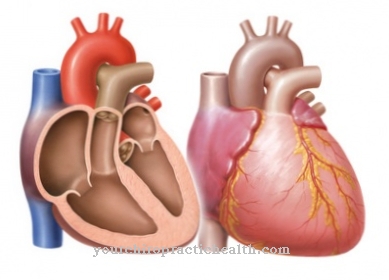Of the Sucking reflex refers to an innate (in medicine unconditional) reflex that is recorded in a number of mammals - humans are one of them. Usually, however, this reflex is unlearned during adolescence. In humans, this usually happens within the first year of life.
What is the sucking reflex?

Medicine and biology understand the sucking reflex to be an unconditional and thus innate reflex that is present in most mammals. Usually this reflex disappears as you grow up. How long it exists, however, depends on the type of mammal. In humans, a decrease in the reflex can usually be noticed towards the end of the first year of life.
The sucking reflex is triggered in a child, for example, when the lips and the tip of the tongue are touched. If this is the case, the baby will begin to suckle on its own. When breastfeeding on the mother's breast, for example, this ensures that the baby sucks the mother's milk out of the breast. In addition, the child exerts pressure on the nipple and thus on the milk duct with the tongue, which also forces the milk out. Only when feeding with the bottle is actually only sucking - but in most cases even babies learn that very quickly.
Function & task
The sucking reflex basically serves to maintain the mammal in its youngest form. It should ensure that the offspring are able to be fed even at a young age. Because of this, the sucking reflex is actually a natural reflex. This is why infants and babies of other mammal species suck or squeeze immediately when something is brought to their mouth - such as a hand or a finger.
The sucking reflex involves a number of muscles and nerves in the face and the rest of the body. The list of muscle groups that work together in the sucking reflex is long: the best known are the muscles of the floor of the mouth, the muscles of the lips, the muscles of the cheek and the muscles of the tongue.
However, if the sucking reflex is disturbed in an infant or not present to a healthy extent, it becomes difficult to feed it, especially in the first months of life. Because during this time, numerous processes of the body still take place rather subconsciously. There are now numerous aids for this. However, these do not always bring the desired success.
The sucking reflex is fundamentally lost during adolescence when it is no longer needed for life support. This is the case, for example, when the boy or baby begins to eat other types of food besides breast milk. In humans, the reflex usually disappears within the first year of life. However, since the natural process of sucking is learned during this time, it is usually still possible to breastfeed a toddler or bottle feed it afterwards.
Illnesses & ailments
A healthy and young baby is born with various unconditional reflexes and reactions. In humans, for example, these are reflexes and reactions such as the sucking reflex, the grasping reflex and the walking reflex. These reflexes all take place subconsciously and serve the growth and, as with the suckling reflex, the survival of the baby.
However, there are also cases and diseases in which the sucking reflex may be damaged, impaired or completely absent. Added to this is the complexity of the swallowing and sucking processes, which means that they can be impaired by numerous diseases - such as the muscles.
Myotonic dystrophy, for example, is a well-known muscular disease that often affects the sucking and swallowing reflexes. This is genetically inherited, but according to current studies only occurs in 5 out of 100,000 cases.
If, for example, there is damage to or diseases of the brain, the reflexes and thus the sucking reflex are sometimes impaired. There are also things like a congenital weakness in sucking, in which the sucking reflex is present but only very weak. In addition, there can be errors in the swallowing reflex, which is very closely related to the sucking reflex and is also vital for an infant.
Medicine offers numerous ways and means to strengthen a weak sucking reflex or to be able to feed babies who do not have one. If the sucking reflex is weak, the child can be fed, for example, through special attachments or through bottles with very soft teats that do not require too much pressure and suction. However, especially with severe damage or impairment of the sucking and swallowing reflex, these do not always bring the desired success. Artificial nutrition is often inevitable here.













.jpg)

.jpg)
.jpg)











.jpg)